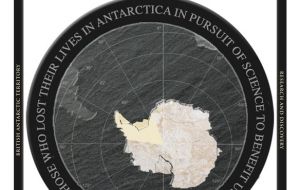MercoPress. South Atlantic News Agency
Memorials in London, Cambridge and Falklands remember Britons lost in Antarctica
 The memorial plaque at St. Paul’s Cathedral, “Research and Discovery”
The memorial plaque at St. Paul’s Cathedral, “Research and Discovery” Two memorials dedicated to Britons who lost their lives in the service of science in Antarctica are unveiled this week. Since 1948, a total of 29 people have died in the British Antarctic Territory, one of the most extreme, inhospitable and uncharted places on Earth.
The memorials, in St Paul’s Cathedral, Cambridge and the Falkland Islands have been commissioned by the British Antarctic Monument Trust (BAMT), a British charity set up to celebrate the achievements of the men and women whose scientific exploration of Antarctica has led to a new understanding of our planet.
A memorial plaque made of Welsh slate and Carrara marble, with the words “For those who lost their lives in Antarctica in pursuit of science to benefit us all”, will be dedicated in the crypt of St Paul’s Cathedral in London. Friends and family of the deceased will attend and lead a special Evensong on 10 May.
Canon Mark Oakley, Treasurer of St Paul's, who is dedicating the memorial in the cathedral says, “St Paul's is honoured to house this memorial to those British men and women who lost their lives for the sake of scientific research and discovery in the British Antarctic Territory. We hope that this memorial will both give comfort to their bereaved families and colleagues as well as remind all passers-by of those sacrifices that are made to understand the amazing intricacies of our planet and the cost of thinking we are somehow divorced from them.”
At a reception after the service Jane Rumble, Deputy Commissioner of the British Antarctic Territory at the Foreign and Commonwealth Office, and Professor Nick Owens, Director of British Antarctic Survey (BAS), spoke in remembrance of those Britons who died in the British Antarctic Territory in service of BAS, its predecessor FIDS (Falkland Islands Dependencies Survey), the Royal Navy and the Scott Polar Research Institute (SPRI).
The BAMT has also commissioned a monument consisting of two distinct, linked public sculptures separated by 8000 miles but united in purpose. The first sculpture, over three metres high and carved from British oak, will be installed in the gardens at the Scott Polar Research Institute in Cambridge (adjacent to its recently refurbished Polar Museum). It will be unveiled by the SPRI Director Professor Julian Dowdeswell on 12 May.
Fundraising continues for the second sculpture, a three-metre high needle of stainless steel, to be erected in Stanley, capital of the Falkland Islands and gateway to Antarctica for most British scientists and support staff.
Donations can be made at www.antarctic-monument.org.
Roderick Rhys Jones, chairman of the BAMT, who is spearheading the project says, “I was a surveyor on an expedition from the BAS Research Station Halley Bay in 1965, when three of my colleagues were killed when their tractor fell into a crevasse. I have never forgotten them and wanted to create a lasting monument to them and the others who lost their lives in the pursuit of science in Antarctica. The response has been overwhelming.
Families, friends and colleagues of those who died have donated generously and will be attending the service in St Paul’s from all over the world including Australia, Mexico, Canada and the US.”
The memorial plaque at St. Paul’s Cathedral has been designed by the artist Graeme Wilson and the stone mason Fergus Wessel. The circular plaque, 1100mm diameter, is made of riven Welsh slate with a map of Antarctica inset in white Carrara marble. A huddle of Emperor penguins is carved at the base of the plaque. The words “For those who lost their lives in Antarctica in pursuit of science to benefit us all” are inscribed around the periphery.
Around the rim is the title “British Antarctic Territory” and its motto “Research and Discovery.” The slate was supplied by the Berwyn Slate Quarry Ltd, Llangollen and prepared for carving by Cerrig Ltd, Pwllheli using advanced water jet cutting techniques.
The Cambridge/Falklands monument has been designed by the distinguished sculptor, Oliver Barratt, who also created the Everest monument which is located one day’s climb from Base Camp. For the Antarctic Monument he has created a unique work which is in two parts - one in the United Kingdom and the other in the Falkland Islands – gateway to the Antarctic for British Antarctic personnel.
The Northern half of the sculpture consists of two oak pillars which create a long needle shape between them, from which the stainless steel needle to be placed in the Falklands is taken. The monument reflects the environmental and scientific link between Britain and the Antarctic whilst at the same time recognising the emotional and physical separation experienced by explorers and their families.




Top Comments
Disclaimer & comment rules-

-

-

Read all commentsThere will always be a tiny piece of land, somewhere in the world, that will always be British,
May 10th, 2011 - 09:37 pm 0Long may you rest in peace .
Ok brainwashed briton, whatever you say.
May 10th, 2011 - 09:58 pm 0Throwing more fuel into the fire, eh Mercopress?
No such thing as “British Antarctic Territory”, but you can make donations at www.antarctic-monument.org. since they can't pay for a f@cking statue.
“ .. No such thing as “British Antarctic Territory”, ...”
May 11th, 2011 - 12:03 am 0You must work very hard to be wrong all the time.
http://en.wikipedia.org/wiki/British_Antarctic_Territory
Commenting for this story is now closed.
If you have a Facebook account, become a fan and comment on our Facebook Page!